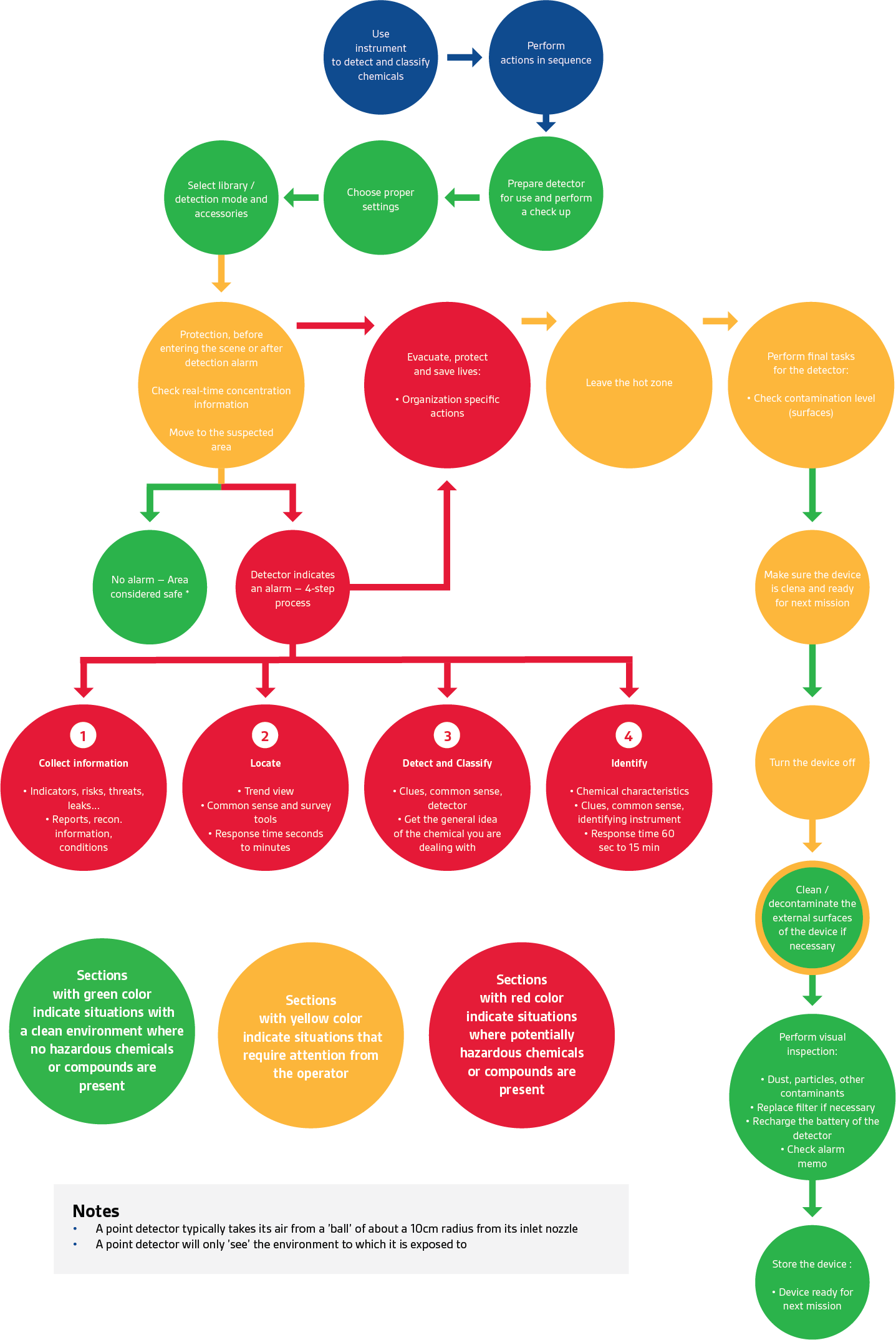Quick Detection VS Accurate Identification
First things first, chemical detection requires three distinct components:
- Proper techniques
- Suitable equipment
- Knowledge and experience to use and apply both tools and techniques
1. Choose an appropriate instrument for the mission
It is important to know and decide, what kind of instrument to use and is it suitable for the expected threat(s). Unfortunately, there isn’t such technology that is capable to detect all kinds and forms of chemical, radiological and biological threats in a one package, with reliable results. Even when talking about e.g. chemical detection alone, different measurement technologies have their strengths and weaknesses when it comes to certain types of chemicals or environments.
Therefore, it is vital for a first responder team to understand the characteristics of the detectors and surveying tools they possess, what are they capable of, and when and where should they be used.
Chemical detector or analyzer?
One key aspect in choosing the correct instrument for chemical survey is knowing what kind of information is necessary, and in what kind of situations. Roughly speaking, chemical measurement instruments can be divided into two different categories: detectors and analyzers.
Handheld chemical detectors should be used a ’first indicator’ to get the information of a possibly present hazardous chemical, as quickly as possible. Many times, combining the detection information from a handheld chemical detector with other reports, reconnaissance information, and observations is enough to make efficient decisions. However, sometimes it may be necessary to further analyze what the target chemical is, and this is where chemical analyzer comes in. Response time with handheld chemical detectors is seconds, whereas chemical analyzers may take tens of minutes to fully complete the analysis; it is important for the operator to understand the role of each type of instrument that is used in the field.
2. Before Chemical Detection Mission
Before setting off on a mission, the operational capabilities of the handheld chemical detector have to be verified. Be sure that:
- Battery is fully charged
- Possible calibration or confidence check has been conducted successfully
- Settings such as time and date and alarm volume level are adjusted correctly
- In order to avoid unreliable detection capabilities and/or false indications, it is extremely important that the detector is turned on in a clean environment before entering the hot zone
3. Choose the appropriate detection mode
In addition to preparing the handheld chemical detector for use, it is also important to check and understand the operational settings of the chemical detector. Many detectors offer different operational settings for selective use; for example, separate detection modes (or libraries) for Chemical Warfare Agents and Toxic Industrial Chemicals. It is a good practice to prepare – if possible – multiple detectors and / or survey tools for the mission and understand when to use them. There are things certain meters or technologies are not capable of detecting, therefore, verifying the possible threats with multiple methods and meters that support and complement each other can lead to more efficient decision making.
4. Preparations before entering the hot zone
Generally, first responders always wear “basic level” protection when entering the hot zone. The level of protection depends on the gathered preliminary information and estimation. However, not all risks are obvious and visible. Many chemicals are invisible and odorless; new threats inside the hot zone can also occur rapidly. These are examples why having an array of detectors and survey tools, and getting the information of the threat rapidly is vital for the operator. With the help of chemical alarms provided by the detector, operator can adjust the level of personal protection based on the nature of the threat.
5. What if the chemical detector indicates an alarm?
- No alarm – Target area is considered safe
- Detector indicates an alarm, what to do?

6. Evacuate, protect and save lives
In case of chemical accident / attack multiple units of first responders are dispatched into the field. Top priority is always, of course, to save lives and evacuate casualties away from the immediate source of danger. However, it is extremely important to simultaneously investigate the characteristics of the chemical threat. Getting the correct information by using a handheld chemical detector, and survey tools, plays a key role when establishing first aid and decontamination lines on site and in the hospitals.
Especially handheld chemical detectors should be utilized when monitoring the chemical concentration levels; it is vital to ensure that the area of immediate threat is neutralized and decontamination processes have been effective.
7. Leave the hot zone once the threat has been neutralized
Ensure there is no possibility for further risks and / or casualties. With the help of handheld chemical detector, screen:
- The area of threat; surfaces, nearby areas where the chemical source was
- Casualties (before and after decontamination)
- Operators and their equipment (before and after decontamination)
8. Prepare the chemical detector for next mission
After mission, ensure the chemical detector is next ready for the next moment it may be needed:
- Ensure there is no chemical residue left in the insides of the detector
- Visually inspect the detector for any residual dust, particles or other contaminants
- Clean / decontaminate the external surfaces of the chemical detector, if necessary
- Charge the battery
- Store the chemical detector in accordance to the instructions stated by the manufacturer
Chemical Detection Flow Chart
The following chart summarizes all the above information.

*It is important to remember that a chemical detector should only be considered as an extension for human senses. No instrument will replace common sense in the manner that an operator could only rely on the results that chemical detector indicates.
Have you been in the hot zone and used similar procedures? Was this helpful for your daily actions? Let us hear your testimonial in the comments section.

Leave a Reply